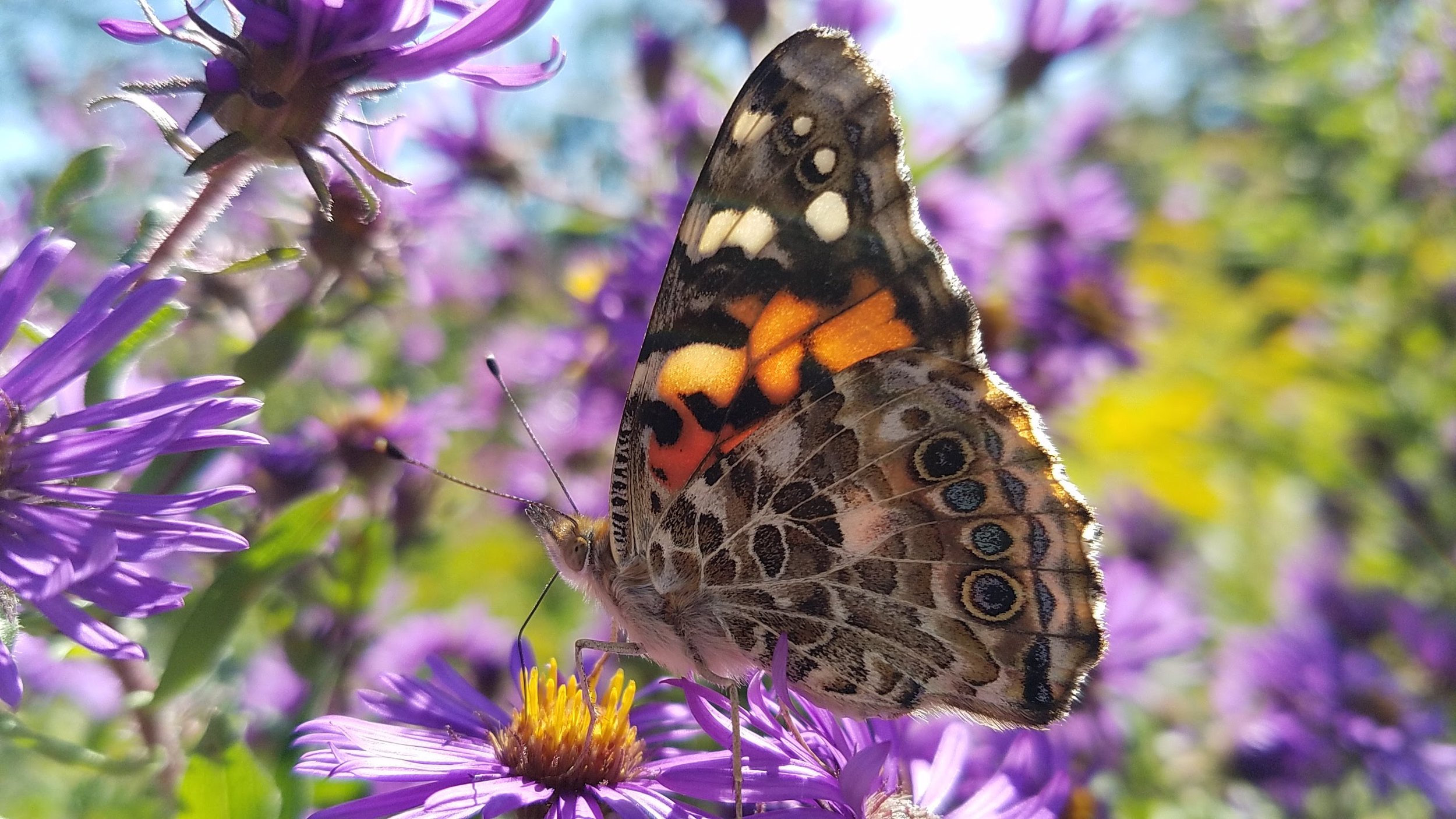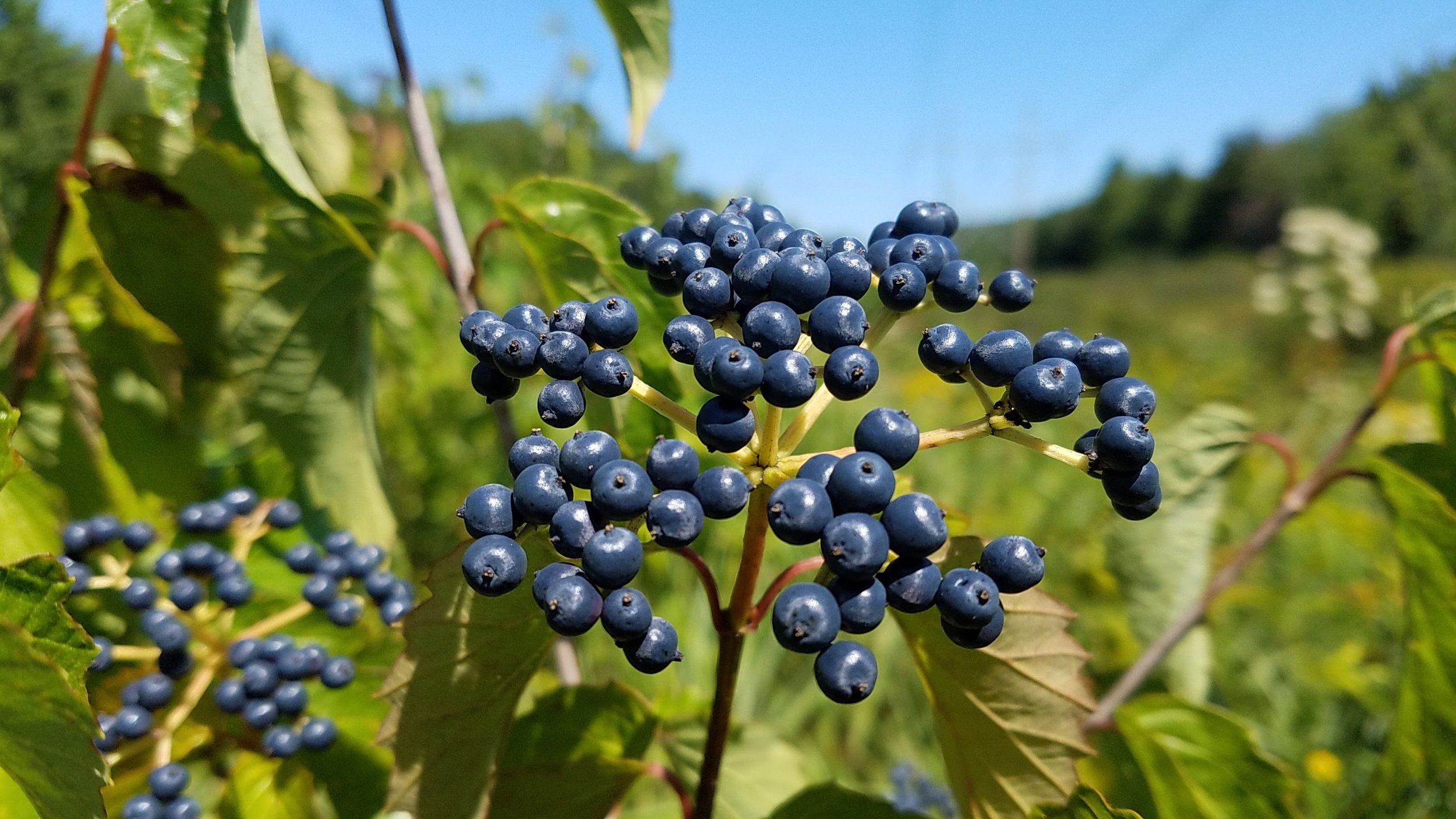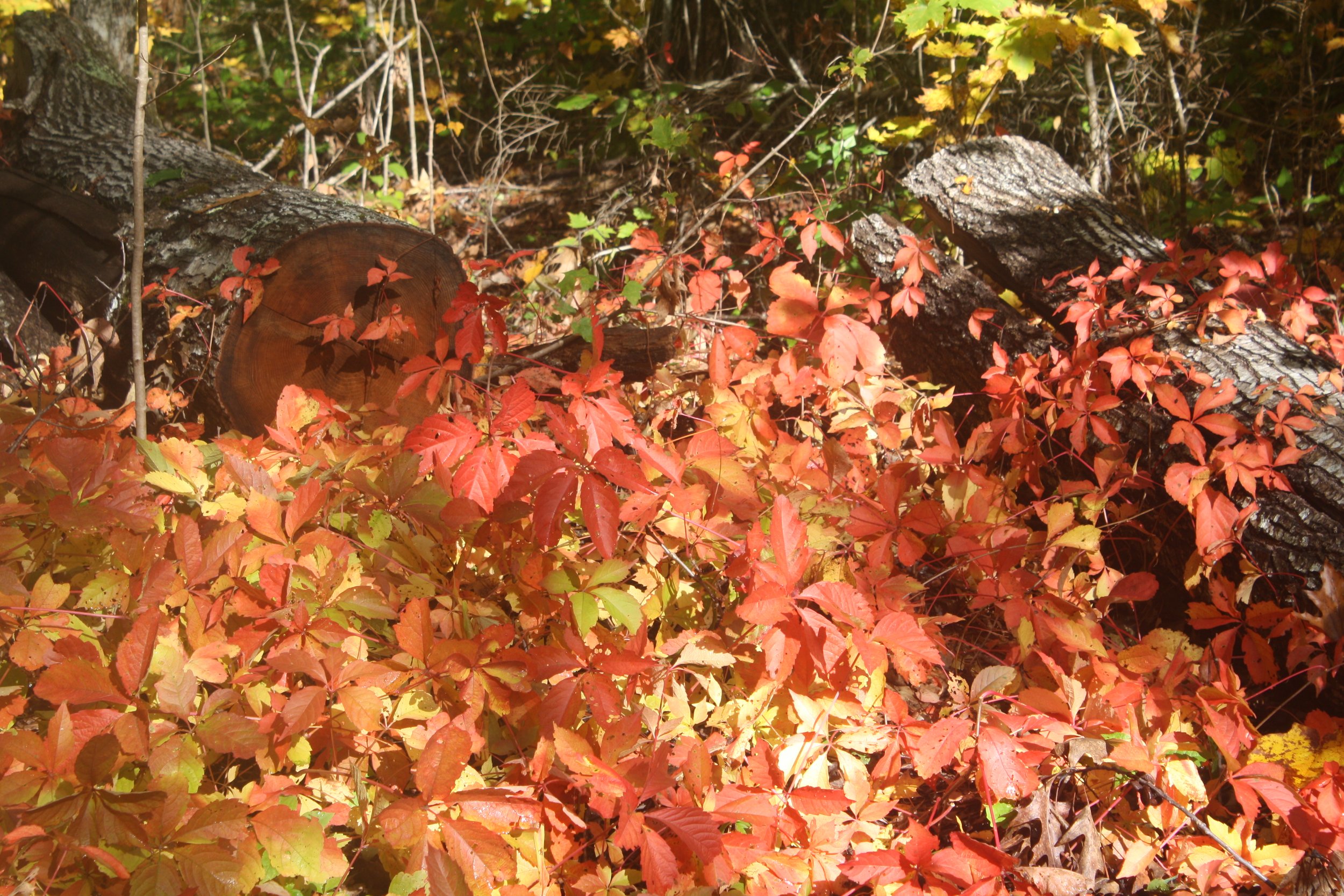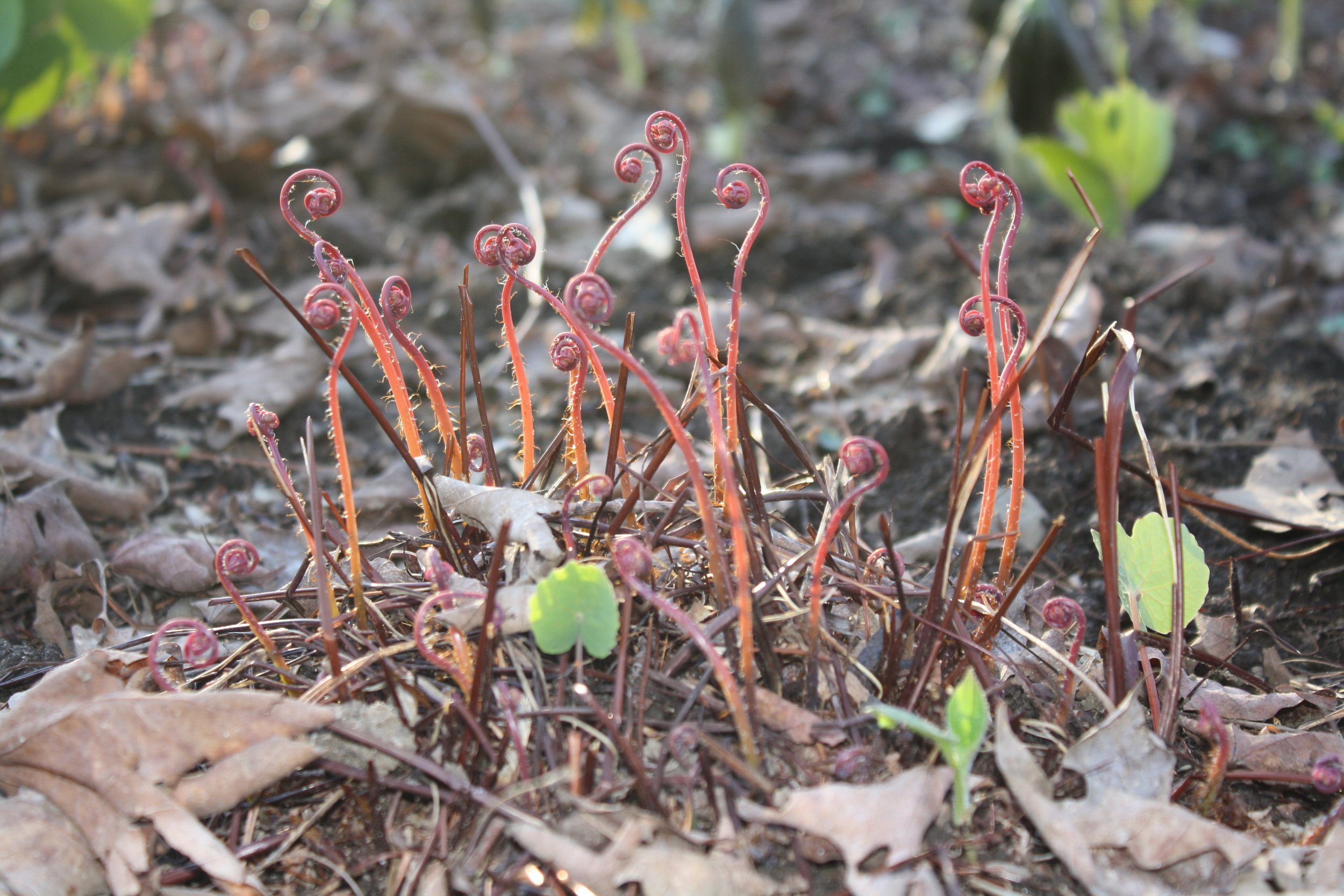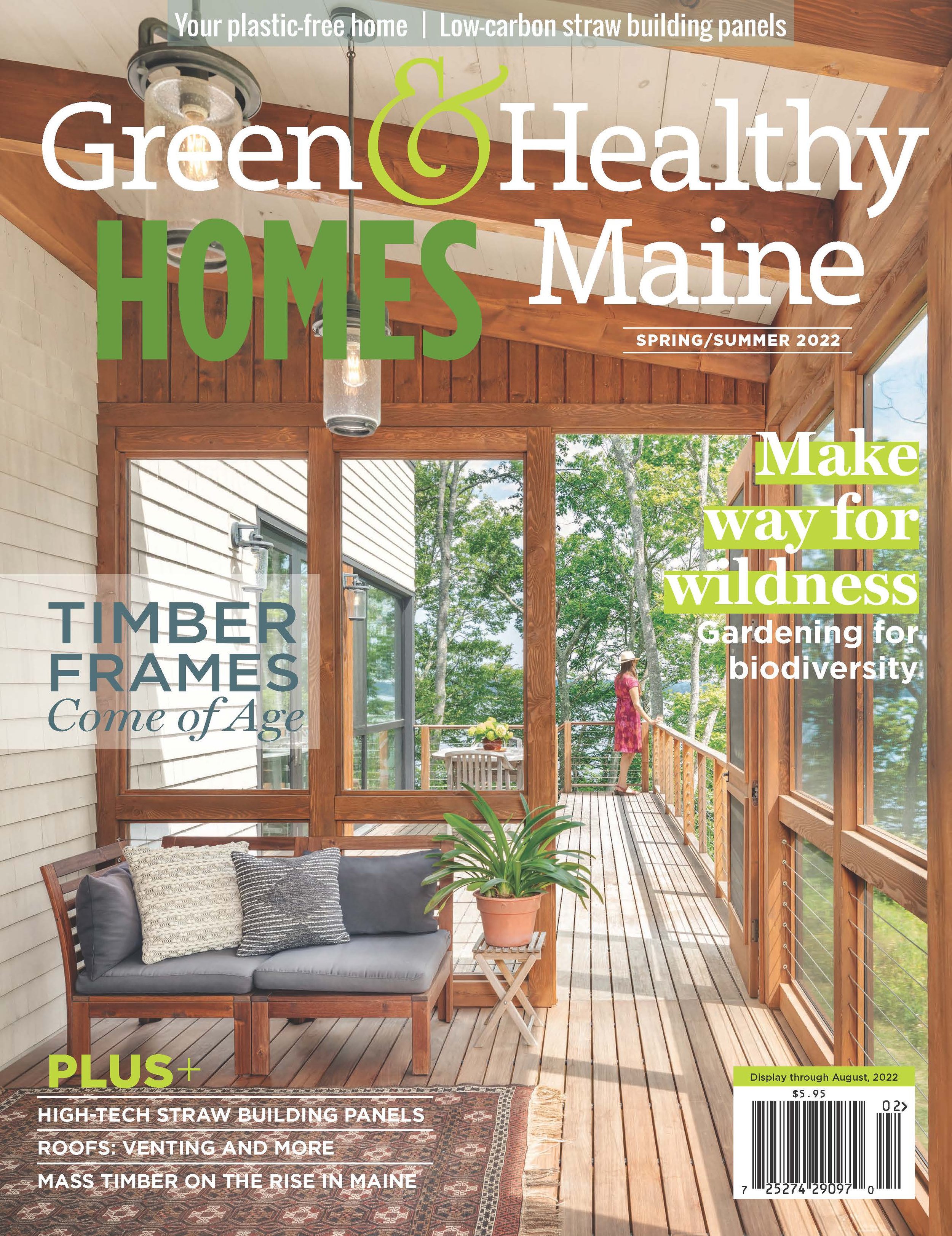Gardening for beneficial biodiversity
Making way for wildness
How to garden for beneficial biodiversity
By June Donenfeld
WHEN EMILY BERNHARD moved into her home on Munjoy Hill in Portland two decades ago, she knew nothing about rewilding, invasive species or the many vital benefits that native plants bring. She planted her postage-stamp garden with what she calls “the usual suspects,” like holly, lilacs and climbing hydrangeas, and adopted a que sera sera approach to the rest of the space, just nurturing what she calls the “green volunteers” that popped up on their own. But over time, she noticed few bees in her garden—and learned that almost all of these “volunteers” were, in fact, invasive plants that didn’t provide the sustenance that the native wildlife needed to survive, let alone thrive. So Emily and her husband, Joseph Brunette, removed the invasives and a third of their asphalt driveway, replaced them with brick walkways and new planting beds, and introduced native plants. Now, she proudly reports, they have “seven trees growing on this tiny plot, including an oak, three birches and an elm,” which can support hundreds of species of native insects. And last summer, along with the monarch butterflies Emily spotted in her garden, she says she spotted the first dragonfly she had ever seen in Portland, which she found deeply gratifying.
Michelle Smith, also of Portland, has a small, urban garden that has undergone a complete turnaround, too. “When we moved in, the yard consisted of grass and unmaintained evergreen shrubs,” she says. “It was the classic dull and lifeless suburban yard. We knew immediately we wanted to transform our plot into a place with color, beauty and habitat that could support pollinators and local wildlife.” And with time and happy effort, she and her family have accomplished just that.
It all adds up
These may sound like unremarkable victories, but their implications are huge: if each of us does what we can, we can help restore the wild web of living things that is vital to our survival, even as we get the additional joy and satisfaction of creating a thing of beauty, no matter how small. To get some expert guidance, I spoke with three Maine native plant experts who had a wealth of knowledge to share. Emily Beckford has run native plant nursery Rebel Hill Farm in Liberty with her husband, Pete, for three decades; Anna Fialkoff is the ecological programs manager at Wild Seed Project in Portland and former Senior Horticulturist at the Native Plant Trust in Massachusetts; and Shawn Jalbert is a native plant advocate, plant biologist, consultant and educator who runs Native Haunts in Alfred. He also runs a native-plant nursery and can source the ones he doesn’t have on hand. Self-taught gardeners Bernhard and Smith also give some valuable suggestions for other people eager to get down and dirty with native plants in their own gardens.
Wood phlox (Phlox divaricata). Photo: Joseph Brunette.
Let’s start at the very beginning
“The most important thing,” says Beckford, “is to learn your land.” That means familiarizing yourself with things like its moisture levels and soil and light conditions, as well as the plants that are already there. “What are the invasive plants and what is intact native planting?” Beckford asks. “There may be intact areas that you should just leave alone.” For a terrific set of succinct, user-friendly instructions on how to learn about your site and its growing conditions, Wild Seed Project has a guide they send to people who pledge to rewild their garden.
What if everything just “looks green” to you? Jalbert reassures us that purposeful plant observation “might be overwhelming at first, but you’ll quickly learn how to weed through them—no pun intended.” He feels that self-education is vital, whether from the online material offered by top-notch organizations, professional webinars, apps like PlantSnap or Google Lens or tried-and-true field guides. “You just need to know when something new appears in your garden or is simply different from other plants there,” he says, “and that will start you off in the right direction of identifying plants.” Another great plant identifier is the Simple Key from the Native Plant Trust that can help you identify more than 1,200 common native and naturalized New England plants. You can also work with a consultant to assess what you have and map out a path to help you achieve your garden goals; you can find some of them listed through the Ecological Landscaping Alliance.
Out, out, invasives and in, in, native plants
Once you know what friends and foes you have on your land, you can banish the foes by using earth-friendly methods, like cutting, covering or using a home-made organic preparation. Though these techniques may be more time- and labor-intensive, they are preferable to their herbicidal counterparts. Be careful, though, when you get rid of the invasives not to disrupt the native plants, advises Beckford, and do a thorough job on one section before you go on to the next. When you start planning for your new arrivals, focus on the keystone plants for this region, the ones that support the largest numbers of wildlife species. In Maine, these include oak, willow, cherry, birch, poplar and maple trees, shrubs like native viburnums and serviceberry, and perennials like asters and goldenrods.
To help you “plant with a purpose,” as Jalbert puts it, there’s a recent and enormously useful database of native plants and beneficial insects from the National Wildlife Federation, organized by zip code, where you can also store your own list of both for future reference. Each entry gives a number indicating how many different species of wildlife the plant supports. Keep in mind, though, that there are some beneficial insects, like the monarch butterfly and many bees, that feed off only one or two plants, so the number of insects supported by a given plant shouldn’t be your only criterion for selection.
How do you figure out what native plants do well in your garden’s soil and light conditions? The University of Maine Cooperative Extension has abundant information on growing conditions for Maine native plants, especially in their Bulletin #2500, as does Maine Audubon’s Native Plant Finder (mainenativeplants.org). But as you work toward the recommended minimum of 70% native plant biomass in your garden, no matter what plants you decide to use, make sure to get them from a nursery or grow them yourself; to protect native flora and fauna alike, do not get them from the wild.
One of the native plant garden beds in Michelle Smith’s and Patrick Moran’s front yard in Portland. Species include Seaside goldenrod (Solidago sempervirens) and Boneset (Eupatorium perfoliatum). Photo: Michelle Smith.
Work with what you have, not against it
Jalbert urges home gardeners to “work with the landscape you have.” Have poor soil? Put in native plants that do well in that environment. Have wet spots? Ditto. And though you may have heard advice to the contrary, he feels it’s “really not necessary” for home gardeners to get their soil tested before planting, though they can do so if they want through the University of Maine Cooperative Extension.
Fialkoff agrees: “Generally, soil tests are more useful for commercial operations, professionals and vegetable gardeners and can present a barrier for a newbie. It is not really necessary for the average homeowner who wants to add native plants in their yard.”
She usually recommends that people observe their garden to learn about light and soil conditions. “There are also some easy at-home soil tests you can do on your own that don’t require sending soil samples to a lab and then having to interpret the results.” A simple drainage test she suggests is to dig an 8-inch by 8-inch hole, pour water into it and watch how long it takes to drain. Up to an hour? Very fast draining. More than a few hours? Moderately well-draining. A day or more? Very slow draining. While digging the hole, she says that you can look at “the soil layers, texture and coloration.”
No matter what type of soil you have, Jalbert has some cautionary words for home gardeners once they introduce a native plant into their garden that naturally does well in that environment: “You really don’t have to fight nature so hard,” he says, “so don’t make the mistake of ‘editing’ or re-engineering soil in ways that won’t enable that particular native plant to thrive,” like enriching or irrigating it for plants that don’t naturally flourish in rich or moist conditions. In other words, work with the landscape you have, not against it, to get a beautiful, beneficial garden.
Get all the (right) dirt
But when you have soil that has been heavily compacted by paving, you won’t get good results by just letting it be. “When my husband first removed the top of the driveway,” Bernhard says, “I insisted on planting native species before we had really amended the soil and it was, predictably, a flop. The problem was that I hadn’t started with the soil, which is gardening 101. So we moved all the plants out and created ‘lasagna’ beds,” which calls for “layering 5–7 layers of organic matter that rot over the winter.” For a great step-by-step guide with photos, look online for “lasagna gardening + The Spruce” or search within Wild Seed Project’s site for “sheet mulching.”
But what about my vegetable patch?
Do you have to swear off non-invasive, non-native plants that give you pleasure, like those tasty potatoes, which “originally came from the Andes,” as Beckford points out. No. You don’t have to be a purist. “You can keep the innocuous non-native plants that may have special meaning to you or bring you joy,” says Fialkoff. “Bit by bit, year by year, you can slowly push the balance in favor of native plants.” She adds that you can also “incorporate some productive and beautiful native edibles [or ‘edimentals’] into your perennial gardens” that make for delicious eating, like wild strawberries, beach plums and hazelnuts.
Emily Bernhard hard at work on her Portland garden do-over, which included replacing a portion of the driveway with garden beds. Plants include: foamflower (Tiarella cordifolia), native wild ginger (Asarum canadense), kinikinnik, aka bearberry (Arctostaphylos uva-ursi), bunchberries (Chamaepericlymenum canadense), white birch, a.k.a. paper birch (Betula papyrifera), and Canadian goldenrod (Solidago canadensis). Photo: Joseph Brunette.
The lawn and the short of it
Lawns eat up time, money and energy, and they don’t support the multitudes of beneficial insects and birds that the same size native-plant garden would. Here are some good ways to go completely—or partially—lawnless:
“You don’t have to get rid of your lawn entirely,” says Jalbert, “but you do need to garden with a mission. Start by stopping, as the best results we can have are often achieved by doing nothing. Don’t try to re-do your lawn completely in one season: do it section by section. And use turf only as carpeted pathways in the landscape.”
Beckford suggests mowing half the lawn one year, to “keep it open and stop it from becoming woody,” and the other half the next. “Let what’s already there sow itself ” or “integrate interesting native perennials into the lawn.”
Fialkoff suggests the sheet-mulching method: “Instead of digging up your lawn, put down layers of cardboard and mulch to add organic matter to the soil and smother the grass below. Then, after it has broken down, you can plant into it. There are also low-growing lawn-alternatives, like wild strawberry or Pennsylvania sedge. If you want a true lawn alternative that you can play soccer on, though, there may not be a native plant to fit the bill, but micro-clover is a good option or a fine-leaved fescue mix.”
Become your own lawn artist by mowing around certain areas to create freeform, rounded “islands” of wild plants, as suggested by author and New York Times gardening columnist Margaret Roach.
Going down the garden path
As Fialkoff says, “You don’t have to break the bank or your back to go native,” especially if you grow plants from seeds. And once native plants take root, they can be practically maintenance-free. You will have to check for invasives periodically, but all in all, native plant gardening takes much less time.
Smith, too, reminds us to “Go at your own pace and take any pressure off yourself that you have to ‘finish’ your garden. That’s one of the best things about native plant gardening: you are never ‘finished.’ It is a constant learning process.” And that’s a wonderful thing.
Know your terms
Biodiversity is the web of interdependent life that includes plants, animals, fungi, bacteria and other microscopic creatures.
Ecosystems are communities of plants and other interacting organisms, including insects, animals, fungi and microorganisms in their physical environment; forests, freshwater lakes and tidal marshes are examples of Maine’s natural ecosystems.
Ecosystem services are the benefits that healthy ecosystems bring to people, like productive food systems, clean air and water, climate regulation, extreme-weather mitigation, and physical and mental wellbeing.
Exotic species (or exotics) are plant species or animal species introduced into an area—inadvertently or deliberately—from another continent.
Invasive plants (or invasives) are non-native species that spread aggressively and cause disruption in a local ecosystem. Unlike the places they came from, they have no natural predators, so they can outcompete native plants, alter habitats, decrease biodiversity and contribute to species extinctions. All non-native plants are considered exotic, but not all of them are invasive. Queen Anne’s lace is just one example of an exotic plant that is not invasive.
Keystone plants are native species essential to our ecosystems because they support 90% of the caterpillar species that our terrestrial birds rely on to reproduce, as well as all our “specialist” native bee species, ones that visit just one host-plant species, genus or plant family to gather pollen; “generalist” bees collect pollen and nectar from many different plant species.
Native plants form the core of a garden that supports native wildlife. In Maine, native plants refer to species of trees, shrubs, vines, wildflowers, grasses and ferns that grew in eastern North America before Colonial times (as defined by Wild Seed Project and Doug Tallamy, renowned entomologist and wildlife ecologist, whose book Nature’s Best Hope is a must-read). As plant species vary in their ranges, the term “native” is relative; some plants native to New England, for instance, may also be native to Mid-Atlantic or Midwestern states. Two-thirds of the plants in New England’s natural areas are still native; the rest are exotics.
Rewilding is the deliberate process of reintroducing native plants to landscapes in urban, suburban and rural areas to reverse habitat loss, support ecosystem services and bring nature back into people’s daily lives.
Xeriscaping is landscaping or gardening that reduces or eliminates the need for supplemental water from irrigation through the use of drought-tolerant plants.
Below photos: 1. Arrowwood viburnum fruit (Viburnum dentatum). 2. Virginia creeper (Parthenocissus quinquefolia) in its full autumn glory. 3. Hay scented fern (Dennstaedtia punctilobula). 4. Unfolding fiddleheads of newly sprouted Maidenhair fern (Adiantum pedatum). Photos 1 and 3 by Shawn Jalbert. Photos 2 and 4 by Peter Beckford.
Brick walkways in progress in the Portland garden of Emily Bernhard and Joseph Brunette. Photo: Joseph Brunette.
Resources: Gardening for biodiversity
Join in, learn more, get help
Ecological Landscaping Alliance: ecolandscaping.org/member-directory
Edgewood Nursery: edgewood-nursery.com
Homegrown National Park: homegrownnationalpark.org
Maine Audubon: maineaudubon.org/projects/plants
Mt. Cuba Center: mtcubacenter.org/action/conserve
The National Wildlife Federation: nwf.org/garden-for-wildlife/certify
Native Gardens of Blue Hill: nativemainegardens.org
Native Haunts: nativehaunts.com
Native Plant Finder: nwf.org/nativeplantfinder
Native Plant Trust: nativeplanttrust.org
Norcross Wildlife Foundation: norcrosswildlife.org
Rebel Hill Farm: rebelhillfarm.com
University of Maine Cooperative Extension: extension.umaine.edu/gardening
Wild Seed Project: wildseedproject.net
Xerces Society: xerces.org
This article appeared in the Spring 2022 edition of Green & Healthy Maine HOMES. Subscribe today!
Find Maine experts that specialize in healthy, efficient homes in the Sustainable Homes Business Directory.



